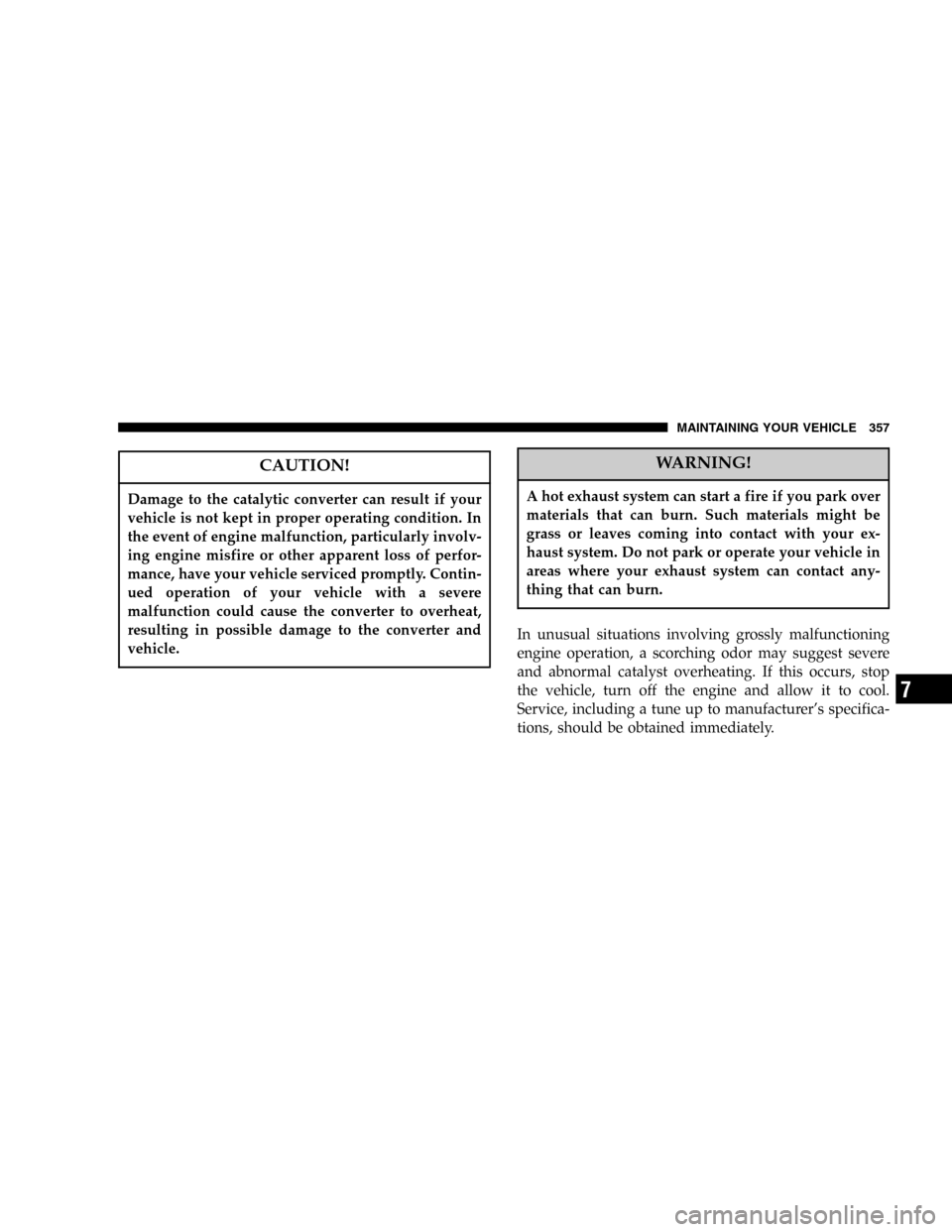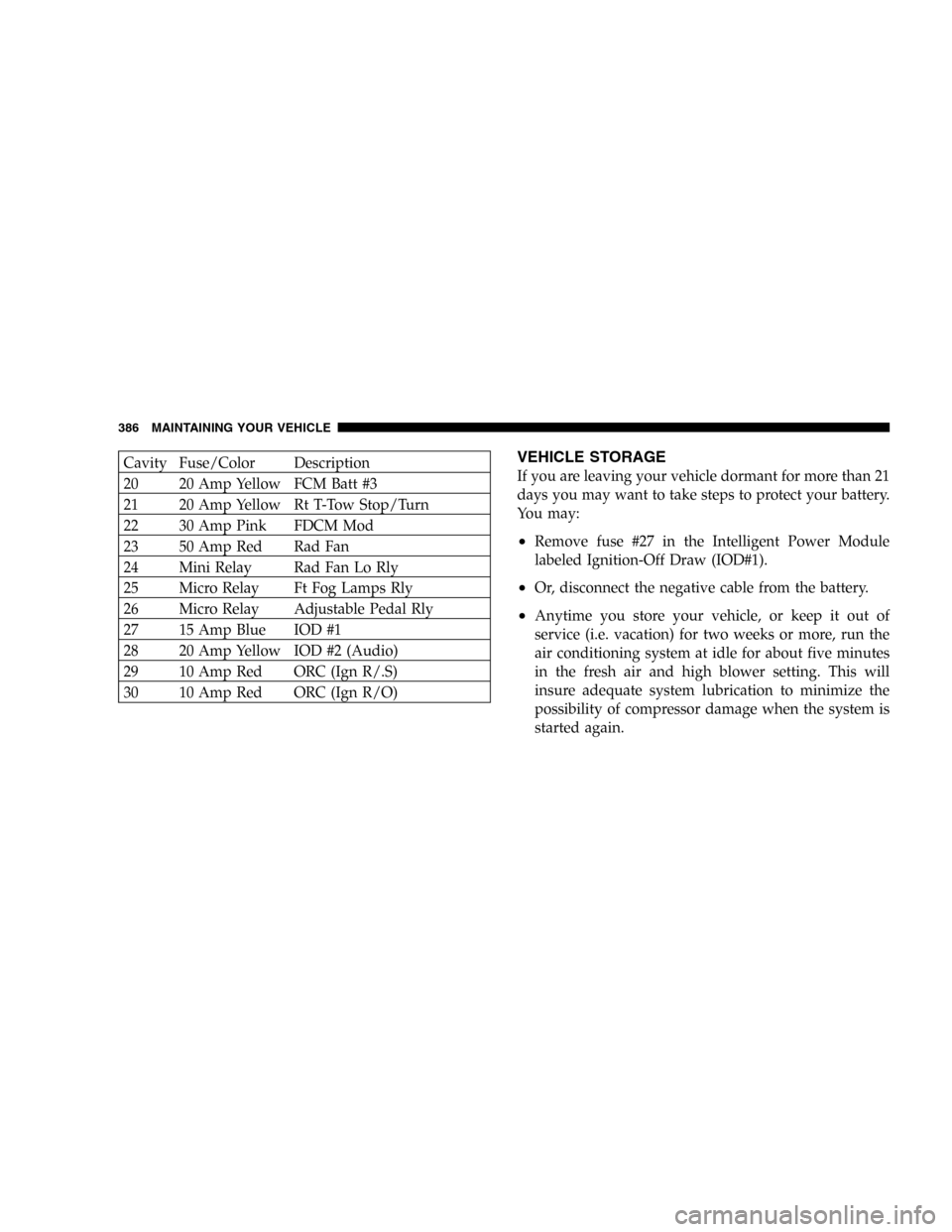stop start JEEP COMMANDER 2006 1.G Owner's Guide
[x] Cancel search | Manufacturer: JEEP, Model Year: 2006, Model line: COMMANDER, Model: JEEP COMMANDER 2006 1.GPages: 440, PDF Size: 1.78 MB
Page 352 of 440

could adversely affect the engine or vehicle performance.
These items should be inspected if a malfunction is
observed or suspected.
Engine Oil
Checking Oil Level
To assure proper engine lubrication, the engine oil must
be maintained at the correct level. Check the oil level at
regular intervals, such as every fuel stop.
The best time to check the engine oil level is about 5
minutes after a fully warmed engine is shut off or before
starting the engine after it has sat overnight.
Checking the oil while the vehicle is on level ground will
improve the accuracy of the oil level readings. Maintain
the oil level in the SAFE level range. Adding 1 U.S. Quart
(0.95L) of oil when the level is at the bottom of the SAFE
range will result in the level being at the top of the SAFE
range.
CAUTION!
Overfilling or underfilling the crankcase will cause
aeration or loss of oil pressure. This could damage
your engine.
Change Engine Oil
Road conditions as well as your kind of driving affect the
interval at which your oil should be changed. Check the
following to determine if any apply to you:
•Day or night temperatures are below 32°F (0°C)
•Stop and go driving
•Extensive engine idling
•Driving in dusty conditions
•Short trips of less than 10 miles (16.2 km)
352 MAINTAINING YOUR VEHICLE
Page 357 of 440

CAUTION!
Damage to the catalytic converter can result if your
vehicle is not kept in proper operating condition. In
the event of engine malfunction, particularly involv-
ing engine misfire or other apparent loss of perfor-
mance, have your vehicle serviced promptly. Contin-
ued operation of your vehicle with a severe
malfunction could cause the converter to overheat,
resulting in possible damage to the converter and
vehicle.
WARNING!
A hot exhaust system can start a fire if you park over
materials that can burn. Such materials might be
grass or leaves coming into contact with your ex-
haust system. Do not park or operate your vehicle in
areas where your exhaust system can contact any-
thing that can burn.
In unusual situations involving grossly malfunctioning
engine operation, a scorching odor may suggest severe
and abnormal catalyst overheating. If this occurs, stop
the vehicle, turn off the engine and allow it to cool.
Service, including a tune up to manufacturer’s specifica-
tions, should be obtained immediately.
MAINTAINING YOUR VEHICLE 357
7
Page 384 of 440

Cavity Fuse/Color Description
20 20 Amp Yellow PCM Batt (Gasoline Only)
21 30 Amp Pink ABS Valves
22 Spare
23 20 Amp Yellow FDCM
24 20 Amp Yellow Fuel Pump
25 20 Amp Yellow FDCM/E-Diff.
26 15 Amp Blue Hyd/PCM (Diesel Only)
27 15 Amp Blue Brake/Stop Lamps
28 25 Amp Natural NGC/Injectors
29 Spare
30 Spare
31 Mini Relay Cabin Htr 1 Rly (Diesel
Only)
32 Micro Relay TCM Rly (Gasoline Only)
33 Micro Relay Starter Rly
34 Micro Relay AC Clutch RlyCavity Fuse/Color Description
35 Micro Relay Fuel Pump Rly
36 Mini Relay Cabin Htr 3 Rly (Diesel
Only)
38 Mini Relay Cabin Htr 2 Rly (Diesel
Only)
39 Mini Relay HVAC Blower Rly
40 Mini Relay ASD Rly
384 MAINTAINING YOUR VEHICLE
Page 386 of 440

Cavity Fuse/Color Description
20 20 Amp Yellow FCM Batt #3
21 20 Amp Yellow Rt T-Tow Stop/Turn
22 30 Amp Pink FDCM Mod
23 50 Amp Red Rad Fan
24 Mini Relay Rad Fan Lo Rly
25 Micro Relay Ft Fog Lamps Rly
26 Micro Relay Adjustable Pedal Rly
27 15 Amp Blue IOD #1
28 20 Amp Yellow IOD #2 (Audio)
29 10 Amp Red ORC (Ign R/.S)
30 10 Amp Red ORC (Ign R/O)VEHICLE STORAGE
If you are leaving your vehicle dormant for more than 21
days you may want to take steps to protect your battery.
You may:
•Remove fuse #27 in the Intelligent Power Module
labeled Ignition-Off Draw (IOD#1).
•Or, disconnect the negative cable from the battery.
•Anytime you store your vehicle, or keep it out of
service (i.e. vacation) for two weeks or more, run the
air conditioning system at idle for about five minutes
in the fresh air and high blower setting. This will
insure adequate system lubrication to minimize the
possibility of compressor damage when the system is
started again.
386 MAINTAINING YOUR VEHICLE